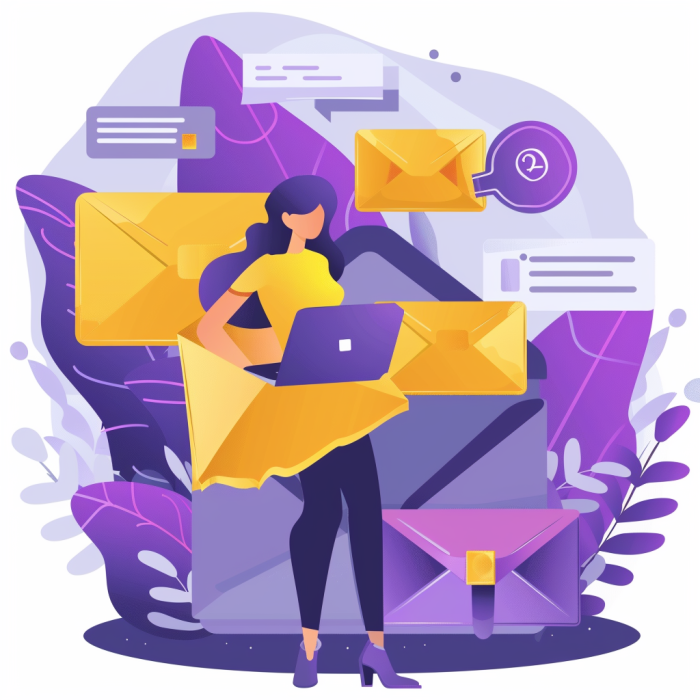The 10 Most Common Email Marketing Mistakes to Avoid in 2024
In the ever-evolving world of digital communication, email marketing remains a cornerstone for building relationships and driving engagement. However, navigating the email marketing landscape in 2024 requires more than just sending out blasts to your subscriber list. At Inagiffy, we've seen firsthand the power of well-executed email campaigns—and the pitfalls of common mistakes. Let's dive into the essential do's and don'ts that will help your campaigns stand out in a crowded inbox.
What are the fundamental email marketing mistakes to avoid?
Email Marketing Mistake: Ignoring Personalization
In a digital age where consumers are bombarded with content, personalization is not just preferred; it's expected. Failing to tailor your emails to the recipient can lead to disengagement and high unsubscribe rates. Key Takeaway: Use data insights to craft messages that resonate personally with your audience.
Common Email Marketing Mistake: Neglecting Mobile Optimization
With the majority of emails now opened on mobile devices, not optimizing for these platforms is a critical oversight. A mobile-unfriendly email is likely to be deleted in seconds. Key Takeaway: Design your emails with mobile users in mind to ensure a seamless viewing experience.
Email List: Not Regularly Cleaning Your List
An outdated or unsegmented email list can drastically affect your campaign's effectiveness. Sending emails to inactive or irrelevant subscribers can damage your sender reputation. Key Takeaway: Regularly clean your email list to maintain high deliverability and engagement rates.
How to improve your email subject lines for better open rates?
Subject Line: Overlooking the Power of the Subject Line
The subject line is your first (and sometimes only) chance to grab the recipient's attention. A generic or misleading subject line can doom your email to the trash bin. Key Takeaway: Craft compelling, clear, and concise subject lines that intrigue and invite the reader to open.
Email Subject: Failing to A/B Test
Not all subject lines will resonate the same way with every segment of your audience. Skipping A/B testing means missing out on valuable insights that could improve open rates. Key Takeaway: Regularly test different subject lines to discover what works best for your audience.
Best Practices: Ignoring Email Marketing Best Practices
Staying updated with the latest email marketing trends and best practices is crucial. What worked a few years ago may not yield the same results today. Key Takeaway: Keep learning and adapting your strategies to stay ahead in the email marketing game.
Why is list segmentation crucial in email marketing campaigns?
Segmenting your email list
Imagine throwing a dart in the dark, hoping to hit the bullseye. That's what sending emails without segmentation feels like. By dividing your audience based on demographics, behavior, or purchase history, you're not just aiming with more precision; you're also enhancing relevance and engagement. A well-segmented email list means messages that resonate, leading to higher open rates and conversions.
Key Takeaway: Segmentation turns a scattergun approach into a targeted conversation, significantly boosting the effectiveness of your campaigns.
Email marketing campaigns
At the heart of every successful campaign is a message that speaks directly to its recipient. Without segmentation, your emails risk being just another drop in an ocean of digital noise. Personalized, targeted campaigns cut through the noise, delivering content that matters to the people who want to hear it most. Remember, a message that feels personal and relevant is a message that gets read.
Key Takeaway: Tailor your campaigns to segmented lists to ensure your emails are always relevant and engaging.
Email addresses
The humble email address is your gateway to a potential goldmine of engagement and loyalty. Treating it as more than just a string of characters means recognizing the person behind it. Segmentation helps tailor your approach to meet their unique interests and needs, turning generic blasts into meaningful conversations.
Key Takeaway: Respect the email address by using segmentation to deliver value and relevance, nurturing a relationship that grows stronger with each interaction.
When is the best time to send email campaigns for optimal results?
Sending emails at the wrong time
Timing is everything. Sending an email when your audience is most likely asleep or busy can doom it to the unread pile. By analyzing data and understanding your audience's habits, you can pinpoint the sweet spot for engagement. Avoid the one-size-fits-all approach and instead, test different times for different segments to find what works best.
Key Takeaway: Optimize send times based on audience insights to ensure your emails have the best chance of being seen and acted upon.
Marketing automation
Embrace the future with marketing automation. This isn't just about sending emails on a schedule; it's about smartly responding to your audience's behaviors and preferences in real-time. Automated workflows can trigger based on actions like sign-ups or past purchases, delivering timely and relevant content that feels personally crafted.
Key Takeaway: Leverage automation to make your emails timely, relevant, and responsive, enhancing engagement without added manual effort.
Email open rates
In the quest for higher open rates, timing your emails can be as crucial as their content. Data-driven insights into when your audience is most likely to engage can transform your open rates from mediocre to remarkable. Experiment, analyze, and adapt your strategy to find your golden hour.
Key Takeaway: Regularly testing and adjusting your email send times can significantly improve open rates, driving better overall campaign performance.
What are the most effective ways to optimize email content?
Creating compelling email content is both an art and a science. It requires a keen understanding of your audience, a clear message, and the ability to present your ideas in an engaging manner. Let's explore the elements crucial to optimizing your email content for maximum impact.
Email design
Think of your email as a digital handshake, the first impression that can either open doors or close them. A cluttered, hard-to-navigate email design can overwhelm recipients, causing them to disengage before even reading your message. Conversely, a clean, responsive design that aligns with your brand identity enhances readability and engagement. Incorporate visual elements sparingly but purposefully, ensuring they complement rather than compete with your message.
Key Takeaway: A well-thought-out design elevates your message, making it more likely to be read and acted upon.
Email subject line
The gatekeeper to your email's content is its subject line. A compelling subject line sparks curiosity and promises value, making the difference between an opened email and one lost to the abyss of the inbox. Personalize where possible, and avoid clickbait tactics that can harm your credibility. Test different approaches to see what resonates best with your audience, using A/B testing tools available in most email marketing platforms.
Key Takeaway: Your subject line is your first and sometimes only chance to capture attention; make it count by being clear, engaging, and relevant.
Email marketing strategy
An effective email marketing strategy is not about sending as many emails as possible; it's about sending the right email, to the right person, at the right time. This means understanding your audience's needs and behaviors, segmenting your list accordingly, and tailoring your messaging to speak directly to each segment. Regularly review and adjust your strategy based on performance metrics, seeking always to refine and improve your approach.
Key Takeaway: A dynamic, data-driven strategy ensures your email marketing efforts are both efficient and effective, leading to higher engagement and conversion rates.
How can marketing automation help avoid common email marketing mistakes?
Marketing automation has revolutionized the way businesses approach email marketing, offering tools to streamline processes, personalize content, and analyze results. Let's examine how automation can help sidestep some of the pitfalls of email marketing.
Email automation
Automation makes it possible to send timely, relevant emails without the need for constant manual oversight. From welcome emails to re-engagement campaigns, automated sequences can guide your subscribers through a personalized journey, increasing the likelihood of conversion. Use automation to trigger emails based on specific actions, such as a purchase or sign-up, ensuring your message is always pertinent.
Key Takeaway: Automation allows for precise targeting and timing, making each email more effective and reducing the risk of user fatigue.
Follow-up email
The power of the follow-up email cannot be overstated. Whether it's thanking a customer for their purchase or gently nudging a prospect who abandoned their cart, follow-up emails show your audience that you value their engagement. Automation ensures these important touches don't fall through the cracks, keeping your brand top of mind and fostering loyalty.
Key Takeaway: Timely, automated follow-up emails build relationships and encourage repeat engagement, turning casual browsers into loyal customers.
Successful email marketing
The hallmark of successful email marketing in 2024 is the integration of automation with a deep, data-informed understanding of your audience. Automation tools provide the capabilities to segment your audience, personalize messaging, and analyze the effectiveness of your campaigns, allowing you to continuously refine your approach for better results.
Key Takeaway: Embrace automation as a partner in your email marketing strategy, leveraging its power to personalize, optimize, and analyze for unparalleled success.
Fun Fact
Did you know that the highest ROI in digital marketing comes from email marketing? For every dollar spent, email marketing generates $42 in return, showcasing its unmatched potential for businesses.
FAQs
How can I make my email content more engaging? A. Focus on clear, concise messaging that addresses your audience's needs and interests. Use visuals judiciously, personalize your content, and always include a clear call to action.
What's the biggest mistake to avoid in email marketing? A. Not segmenting your audience can lead to generic, irrelevant messaging. Tailor your emails to different audience segments to increase engagement and conversion rates.
How does email marketing automation benefit my strategy? A. Automation ensures timely, relevant, and personalized communication with your audience, improving engagement, conversion rates, and customer retention.
Can I measure the success of my email marketing efforts? A. Absolutely. Use metrics such as open rates, click-through rates, conversion rates, and email ROI to gauge the effectiveness of your campaigns and inform future strategies.
Inagiffy: Your Ultimate Newsletter Marketing Partner
In today's crowded digital landscape, building genuine, lasting connections with your audience is more crucial than ever.
Enter Inagiffy – a premier newsletter marketing agency that understands the transformative power of well-crafted newsletters. We're not just about sending out emails; we're about curating stories, insights, and value that resonate deeply with your audience.
Our end-to-end solutions ensure that from ideation to delivery, every newsletter reflects your brand's essence and speaks directly to your audience's needs and aspirations. Let Inagiffy empower your brand, forging authentic relationships and driving engagement through the potent medium of newsletters.
Dive into the future of meaningful communication with us and watch your audience grow, engage, and thrive.


Comments
Your comment has been submitted